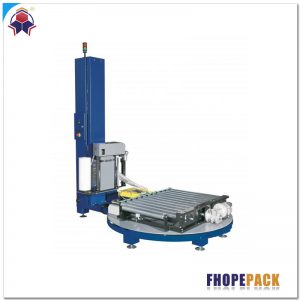
To lock the load onto the tray, we have three methods here.
Here are three common ways that most loads need to be fixed, and they generally need to be pinned to a tray.
Simply wrapping it in the bottom of a tray stretching around the end of the winding loop is the most basic and least effective method. It makes the load particularly vulnerable to the loss of traction from the puncture.
At the bottom of the tray, every time a forklift or pallet is inserted into the tray base, the stretch film will be punctured or torn, and the risk of tearing will need to be taken.
Some fpc2 packaging machines are making this risk by making a thin film cord. At the end of the stretching loop, the thin film is stuffed into a string resembling an accordion. It is difficult to locate where you want it to be on a tray, and, under the pressure of transport, a thin film of string is often unstrung. With the lifting of the rope, its effectiveness has also been reduced by the sea.
Creating a movie cable is the best way to ensure load to a tray. At the end of the stretch, a taut cable is wound from the last 3 to 5 inches of film. Then the cable was pulled down again and pulled to the panel, about an inch below the deck.
As we all know, a thin film cable is solid enough to hold the load on a tray, but it is also high enough to allow forklift or a fork on the tray to be cleaned.
A good rule of thumb is that each load on the tray, ships should be attached to it doesn’t Pierce or stretch film of tears, is the best way to avoid piercing and tears through the use of a video cable.
Here are three common ways that most loads need to be fixed, and they generally need to be pinned to a tray.
Simply wrapping it in the bottom of a tray stretching around the end of the winding loop is the most basic and least effective method. It makes the load particularly vulnerable to the loss of traction from the puncture.
At the bottom of the tray, every time a forklift or pallet is inserted into the tray base, the stretch film will be punctured or torn, and the risk of tearing will need to be taken.
Some fpc2 packaging machines are making this risk by making a thin film cord. At the end of the stretching loop, the thin film is stuffed into a string resembling an accordion. It is difficult to locate where you want it to be on a tray, and, under the pressure of transport, a thin film of string is often unstrung. With the lifting of the rope, its effectiveness has also been reduced by the sea.
Creating a movie cable is the best way to ensure load to a tray. At the end of the stretch, a taut cable is wound from the last 3 to 5 inches of film. Then the cable was pulled down again and pulled to the panel, about an inch below the deck.
As we all know, a thin film cable is solid enough to hold the load on a tray, but it is also high enough to allow forklift or a fork on the tray to be cleaned.
A good rule of thumb is that each load on the tray, ships should be attached to it doesn’t Pierce or stretch film of tears, is the best way to avoid piercing and tears through the use of a video cable.